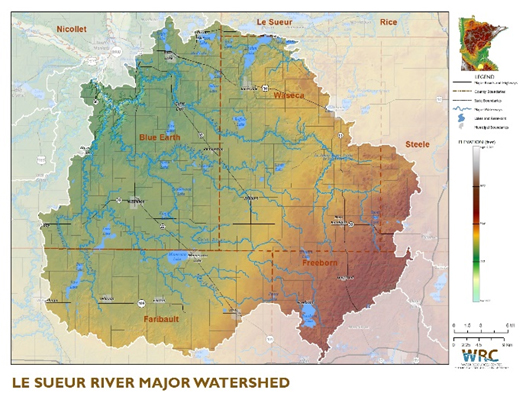

Is erosion to blame?
COVID-19 UPDATE: We are carefully monitoring the COVID-19 outbreak and the recommendations of state and federal health officials. At this time, to avoid unnecessary risk, we are postponing Freshwater at The Lab with Anna Baker. The health and safety of our community members and staff is our top priority. We will reschedule the event as soon as prudent, stay tuned for updates!
FREE PUBLIC EVENT
This event has been postponed
The Lab Taproom
767 N Eustis Street, Suite 115, Saint Paul, MN 55114

Does excess phosphorus fertilizer always move with eroded soil to our waterways? Join Freshwater @ The Lab to hear Anna Baker, hydrologist at the USGS Midwest Water Science Center and 2017 recipient of the Malcolm Moos Scholarship, talk about the tie between sediment loading and phosphorus pollution in one of Minnesota’s most heavily eroding watersheds, the Le Sueur River south of Mankato. We call it the beating muddy heart of the Minnesota River basin.
 Come early to enjoy beer and non-alcoholic beverages at The Lab, an inventive new taproom in Saint Paul near 280 and University.
Come early to enjoy beer and non-alcoholic beverages at The Lab, an inventive new taproom in Saint Paul near 280 and University.
Bio:
Anna Baker is a hydrologist with the U.S. Geological Survey in Mounds View, Minn. Her professional interests include all things water and how to reduce human impacts on our waters. She especially enjoys working in rivers and thinking about sources and pathways for nutrient and sediment pollution to these systems. Anna is a recent graduate of the University of Minnesota’s Water Resources Program, where she worked with faculty advisors Karen Gran and Jacques Finlay to develop a budget for sediment-derived phosphorus for the Le Sueur River Basin.
Abstract:
Phosphorus is a leading pollutant responsible for the degradation of habitat in rivers, lakes, and streams. Because phosphorus binds readily to sediment, for decades erosion control has been considered a primary means of reducing the negative impacts of phosphorus pollution. Despite the successes of erosion control in reducing topsoil loss from agricultural fields, adequate reductions in suspended sediment and total phosphorus in our streams have remained elusive. The Le Sueur River Basin is a disproportionately large contributor of sediment and phosphorus to downstream waters including the Minnesota River and Lake Pepin. Previous work in the Le Sueur has shown that streambank and river-bluff erosion are the primary contributors of sediment, and that this sediment may play a strong role in phosphorus loading. Therefore, we sought to determine the extent to which reducing erosion from all of its sources in the Le Sueur would reduce phosphorus loads in this heavily eroding watershed. Join us to hear our surprising findings and to discuss what this might suggest about how we should focus management to reduce phosphorus and sediment impacts to our rivers, lakes, and streams.
About Freshwater @ The Lab
In addition to supporting Freshwater’s lecture series, the Moos family also offers scholarships to graduate students at the University of Minnesota who are focused on understanding and developing sustainable use of freshwater. Their topics span the disciplines involved in water resources, aquatic biology, and limnology, and are commonly of regional significance. Students come from different departments across the University system.
Freshwater @ The Lab gives these new water resource professionals in-the-making an audience for their important work. Speakers will include current and recent recipients of a Moos Graduate Research Fellowship in Aquatic Biology.